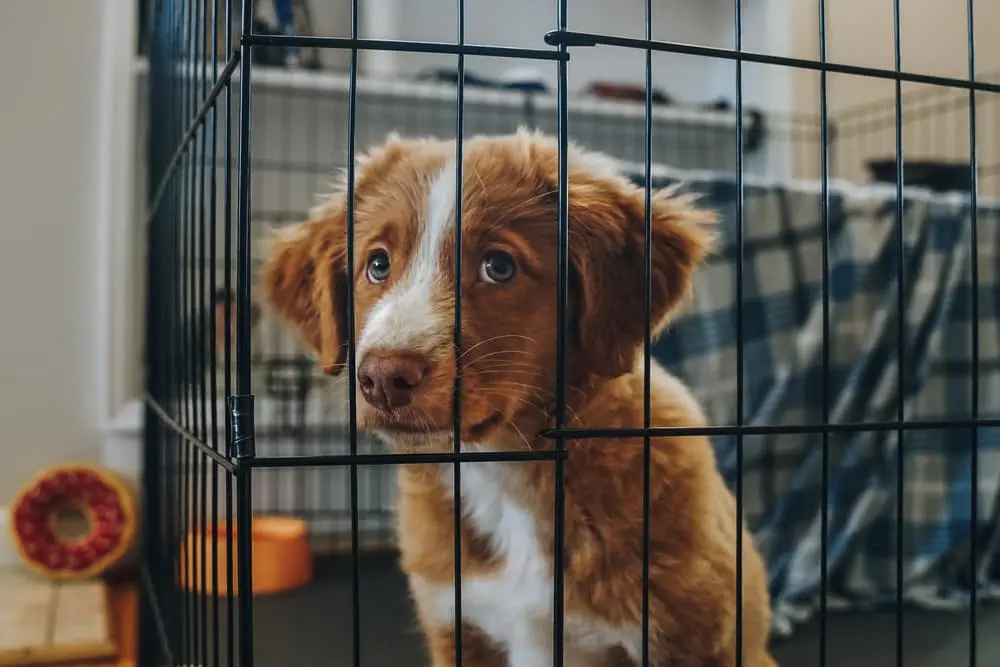With over 15 years working in veterinary consulting and canine behavior, I’ve learned that most crate whining isn’t “naughtiness” — it’s an instinctive response to new surroundings, separation from littermates, or unmet needs. The right combination of comfort, routine, and gradual training can turn those cries into calm in just days.

Table of Contents
Introduction
Last night, my neighbor Rachel called me in tears. Her 10-week-old Labrador puppy hadn’t stopped crying in his crate for three nights straight. Nobody in her home had slept.
If your puppy is whining in the crate, you’re not alone — it’s one of the most common challenges for new puppy parents. Most often, it’s caused by unmet needs (bathroom, comfort, exercise) or anxiety. The fastest way to stop it? Calmly meet their needs, then teach self-soothing with consistent, positive crate training.
In this guide, we’ll cover why puppies cry in crates, proven short-term fixes, a step-by-step long-term training plan, products that really help, mistakes to avoid, and when to call in professional help.
Why Is My Puppy Whining in Their Crate? Understanding the Root Causes
That pitiful crying isn’t manipulation — it’s communication. Puppies whine to express genuine needs or discomfort. Here are the most common reasons:
Separation Anxiety and Pack Instincts
Puppies are hardwired to stay close to their “pack.” Being alone in a crate can feel unsafe at first. As Dr. Karen Becker, integrative veterinarian, explains:
“When we isolate puppies in crates, we’re working against their natural instincts. Patient training and positive associations are key.”
Physical Discomfort or Needs
- Potty break: Puppies can only “hold it” for their age in months + 1 hour.
- Temperature: Too hot or too cold can cause restlessness.
- Bedding: An uncomfortable surface can make the crate feel like punishment.
- Hunger or thirst: Especially if mealtimes are far apart.
- Illness or pain: Whining can be an early sign of discomfort — if sudden, see your vet.
Case in point: My Beagle puppy suddenly started whining after weeks of quiet nights — the culprit? He’d outgrown his bed, and the crate floor was uncomfortable. A bedding upgrade solved it instantly.
Lack of Proper Crate Training
If your pup only experiences the crate when you leave, it’s natural they’ll protest. Crates must be introduced gradually, with positive experiences.
Boredom or Excess Energy
An energetic puppy with no outlet will protest confinement. Think of it like trying to put an excited toddler straight to bed.
Reinforced Behavior
If you’ve been opening the crate door the moment your puppy cries, you’ve taught them that whining works.
Quick Wins: Immediate Solutions for Nighttime Crate Whining
These are short-term tactics to bring relief tonight while you work on long-term training.
Perfect the Crate Setup
- Location: Keep the crate in your bedroom or near sleeping family members for initial weeks.
- Comfort: Soft bedding, washable blankets, and a heartbeat plush toy can mimic the warmth and sound of littermates.
- Our top pick: Snuggle Puppy Behavioral Aid Toy — heartbeat & heat pack combo that calms many puppies in the first nights.
- Right size: Enough space to stand, turn, and lie down — no more, no less. For growing pups, use a crate with a divider like MidWest Homes for Pets Dog Crate.
- Partial cover: Drape a breathable cover over 3 sides to create a den-like atmosphere, leaving the front open.
Create a Predictable Pre-Crate Routine
Example (Max, a German Shepherd pup who stopped screaming within a week):
- Last potty break (no play).
- Calm 3-minute back massage.
- Give a stuffed Kong or chew toy.
- Turn on white noise or soft classical music.
- Same bedtime cue each night: “Time to sleep, Max.”
Predictability builds security.
Use Calming Aids if Needed
- Pheromone diffuser: Adaptil Calm Home Diffuser — releases comforting pheromones like a mother dog.
- Heartbeat toys as above.
Long-Term Success: Step-by-Step Crate Training Plan
This gradual approach transforms the crate from “prison” into “safe space.”
Days 1–2: Introduction Without Pressure
- Keep crate door open, toss treats inside randomly.
- Feed meals just inside the crate entrance.
- Never force entry.
Days 3–5: Brief, Pleasant Containment
- Close door for 30 seconds with a stuffed Kong.
- Stay visible.
- Gradually increase to 5–10 minutes, always ending before whining starts.
Days 6–14: Building Duration
- Extend crate time slowly.
- Start short departures from the room.
- Return before anxiety escalates.
Example: Chloe, a Cavalier King Charles Spaniel, went from panic to voluntarily napping in her crate within two weeks using this exact plan.
Exercise Before Crate Time
- 15–20 minutes of age-appropriate physical activity.
- 5–10 minutes of mental games (training, puzzle feeders).
- 5 minutes calm decompression.
Reserve Special Rewards for Crate Time
- Stuffed Kong Puppy Toy with frozen plain yogurt + peanut butter.
- Lick mats with puppy-safe toppings.
- Rotating safe chew toys to maintain novelty.
Common Mistakes That Make Whining Worse
- Using the crate as punishment — builds fear, not comfort.
- Opening mid-whine — teaches that crying = freedom.
- Rushing training — skipping gradual steps leads to setbacks.
- Inconsistent use — puppies thrive on predictable routines.
When to Consult a Professional
Seek help if:
- Whining escalates after weeks of training.
- Signs of severe anxiety: drooling, panting, escape attempts.
- Sudden behavior change or signs of illness.
FAQ
How long should I let my puppy cry?
If all needs are met, allow 5–15 minutes depending on age, then briefly check without opening the crate.
Should the crate be in my bedroom?
Yes, at least initially. Gradually move it once your pup is confident.
Is it cruel to crate a puppy while at work?
Young pups shouldn’t be crated longer than their age in months + 1 hour. Use midday breaks or a pen with potty area.
Can I cover the crate?
Yes, but ensure ventilation and a view of you if it reduces anxiety.
Conclusion
Crate whining is a normal phase — but with patience, consistency, and empathy, it’s one you can overcome. By understanding your puppy’s needs, introducing the crate gradually, and using comfort tools wisely, you can transform bedtime battles into peaceful rest.
Rachel’s Labrador? Sleeping soundly in his crate by night eight — and her whole family finally got some rest.
For more on calming tools, see our Vet-Tested Calming Products Guide.

